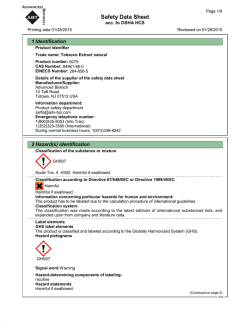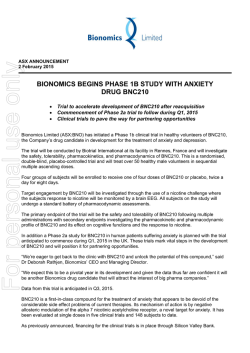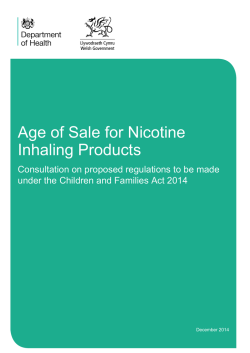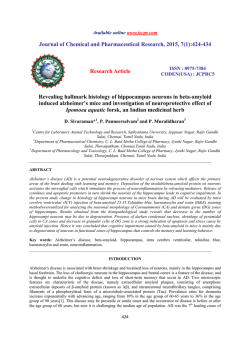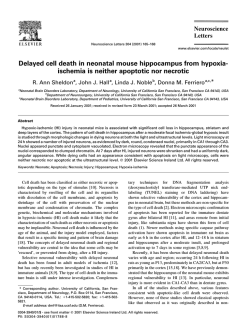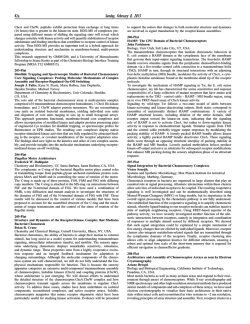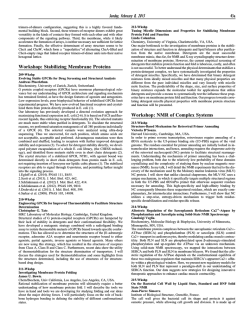
Neuronal Nicotinic Acetylcholine Receptors as Novel Drug Targets
0022-3565/00/2922-0461$03.00/0 THE JOURNAL OF PHARMACOLOGY AND EXPERIMENTAL THERAPEUTICS Copyright © 2000 by The American Society for Pharmacology and Experimental Therapeutics JPET 292:461–467, 2000 Vol. 292, No. 2 Printed in U.S.A. Perspectives in Pharmacology Neuronal Nicotinic Acetylcholine Receptors as Novel Drug Targets G. KENNETH LLOYD and MICHAEL WILLIAMS SIBIA Neurosciences Inc. (G.K.L.), La Jolla, California; and Neurological and Urological Diseases Research, Abbott Laboratories (M.W.), Abbott Park, Illinois This paper is available online at http://www.jpet.org The plant alkaloid, nicotine (Fig. 1), is a commonly used psychoactive drug that is orally self-administered via the chewing or combustion of tobacco products, the latter typically via cigarette use. Cigarettes represent “the most toxic and addictive form of nicotine delivery” (Henningfield and Heishman, 1998). As a result of the rapid rise in plasma concentrations and high peak plasma levels, high bolus doses of nicotine are delivered directly to the brain often leading to dependence liabilities (Stitzer and de Wit, 1998). When administered by other routes, e.g., transdermal patches and via the “smokeless cigarette”, nicotine does not achieve rapid brain access and thus has reduced abuse liability potential. The addiction liability and other negative effects on public health associated with the use of tobacco products, e.g., heart disease, cancer, respiratory disorders (Kluger, 1996; Sapori, 1998), have tended to overshadow the potentially beneficial effects of nicotine. Like many natural products ingested by humans, nicotine has a wide spectrum of biological activities, some beneficial, some detrimental, that result from its inability to discriminate between the different subtypes of nicotinic acetylcholine receptors (nAChRs) present in the body (Williams and Arneric, 1996; Menzaghi et al., 1998). Acting via members of the neuronal nAChR family, nicotine has well documented effects on cognitive and motor function and cerebral blood flow and has effects at the molecular level that may be the genesis of novel compounds that have analgesic, neurorestorative, antianxiety, antidepressant, and antipsychotic activities (Decker et al., 1999). Nicotinic Receptors Nicotine produces its actions on mammalian tissue function via interactions with a family of ligand-gated ion chanReceived for publication September 10, 1999. nels (LGICs; Gotti et al., 1997; Holladay et al., 1997; Changeux et al., 1998) that due to their tissue distribution and functional attributes (which differ between species) differentially modulate the effect of the alkaloid on nervous, cardiovascular, immune, and neuromuscular system function. Neuronal nAChRs are named on the basis of their subunit components, e.g., ␣42, and are thought to have a pentameric functional motif formed from a variety of subunits that comprise an ion channel similar to that of the neuromuscular junction nAChR (Fig. 2). Eleven neuronal nAChR subunits, eight ␣ (␣2–␣9) and three  (2–4), have been identified in mammalian species. Each subunit has four transmembrane spanning regions, M1–M4, the second of which, M2, forms the wall of the channel (Changeux et al., 1998). The pentameric motif has the potential for a large number of nAChR subunit combinations including both homomers and heteromers (Fig. 2). However, like other LGICs [e.g., ␥-aminobutyric acid (GABA)A receptor] only a finite number of naturally occurring functional nAChR constructs have been identified to date. The stoichiometry of most nAChRs in the brain is as yet undefined although an abundant brain nAChR, the ␣42, is proposed to have two ␣4- and three 2subunits. More complex combinations with three (␣34␣5) or four (␣324␣5) different subunits have been identified in brain. ␣7-, ␣8-, and ␣9-receptors differ from other nAChRs in being able to form functional homomers in oocytes (Gotti et al., 1997). The neuromuscular nAChR in mammalian adult skeletal muscle has two ␣1- and one each of the 1-, ␥-, and ␦-subunits. Studies delineating the function of the various subunits are ongoing. Antisense oligonucleotides to the ␣4 subunit of the nAChR (Bitner et al., 1998) and ␣4 knockout mice (Marubio et al., 1999) have shown that this subunit is critical to the antinociceptive actions of nicotine and nicotinic agonists in animals. 2-subunit knockout mice show deficits in cognitive function, reduced high-affinity ligand binding ABBREVIATIONS: nAChR, nicotinic acetylcholine receptor; GABA, ␥-aminobutyric acid; ACh, acetylcholine; LGIC, ligand-gated ion channel; n-BgT, neuronal bungarotoxin; NCB, noncompetitive blocker; DHE, dihydro--erthyroidine; DA, dopamine; PD, Parkinson’s disease; 5-HT, 5-hydroxytryptamine ADHD, attention-deficit hyperactivity disorder; MPTP, 1,2,3,6-tetrahydro-1-methyl-4-phenylpyridine; NE, norepinephrine. 461 Downloaded from jpet.aspetjournals.org at ASPET Journals on October 2, 2016 Accepted for publication October 5, 1999 462 Lloyd and Williams Vol. 292 sites (Picciotto et al., 1995), and reduced responses to nicotine in pain models (Marubio et al., 1999). Antisense to the ␣6-receptor subunit can block the nicotine-induced increase in locomotion that is mediated via effects on central dopaminergic pathways (Le Novere et al., 1999). Knockouts for the ␣9-subunit show deficits in olivocochlear function (Vetter et al., 1999). The nAChR is unusual among receptors in that agonistinduced desensitization leads to an up-regulation of the receptor. Ligand interactions occur with various discrete forms of the receptor as originally proposed in 1958 by Katz and Thesleff, e.g., open, resting, and desensitized states that are in equilibrium (Lena and Changeux, 1993). In addition to the acetylcholine (ACh) binding site, the nAChR, like other LGICs, e.g., GABAA (benzodiazepine, neurosteroid, and barbiturate) and N-methyl-D-aspartate (glycine and polyamine), has binding sites for other types of ligand that can modify the equilibrium between the receptor states thus representing the classical allosteric receptor. Site-directed mutagenesis has shown that the binding site(s) for cholinergic agonists e.g., ACh, (⫺)-nicotine, cytisine, and antagonists, e.g., neuronal bungarotoxin (n-BgT), dihydro--erythroidine (DHE), and erysodine on the nAChR is located at the interface between the ␣- and -subunits in heteromeric receptors and between ␣-subunits in homomers (Fig. 2; Changeux et al., 1998). Thus ␣ nAChR homomers have five ACh binding sites whereas heteromers have two. Dramatic differences in ligand pharmacology occur at neuronal nAChRs depending on: 1) whether ␣4- or ␣3-subunits are present, 2) whether 2- or 4-subunits are present; and 3) which subunits are adjacent to one another. A binding site for compounds that increase neuronal nAChR-mediated ion conductance, e.g., cholinesterase inhibitors, physostigmine, and galanthamine, and the antihelminthic, ivermectin (Buisson and Betrand, 1998) is present on the ␣ subunit. These compounds are termed channel activators or positive allosteric modulators. The site at which they act does not manifest the same desensitization mechanisms seen with (⫺)-nicotine. Noncompetitive blockers (NCBs) or negative allosteric modulators include mecamylamine, physostigmine (at a site distinct from the positive allosteric site), histrionicotoxin, chlorpromazine, phencyclidine, MK 801, local and volatile anesthetics, detergents, fatty acids, barbiturates, and n-alcohols. These compounds modulate nAChR function via interactions at two distinct sites that differ from those where competitive blockers act. The first site is present on the M2 transmembrane segments of the nAChR within the pore and binds NCBs in the low micromolar range. This binding is facilitated by the presence of agonist and is thus use-dependent. Ligands acting at this site produce either a rapid reversible channel blockade or shorten channel opening time in Downloaded from jpet.aspetjournals.org at ASPET Journals on October 2, 2016 Fig. 1. Structures of ACh, (⫺)-nicotine, cytisine, and recently described nAChR agonists. 2000 Neuronal Nicotinic Receptors as Drug Targets 463 a voltage-sensitive manner (Lena and Changeux, 1993). At the second low-affinity site, NCBs accelerate nAChR desensitization, shifting the equilibrium toward the desensitized state. Because the ligands that bind to this second site are generally lipophilic, these sites appear to lie at the interface between the nAChR protein and membrane lipids. Steroids can also modulate neuronal nAChRs acting at another allosteric site distinct from both the ACh binding site and the ion channel. Progesterone and testosterone produce a voltage-insensitive inhibition of ␣42, ␣32, and ␣7 nAChRs (Buisson and Betrand, 1998). Dexamethasone, hydrocortisone, and prednisolone are noncompetitive inhibitors of chromaffin cell nAChRs (?␣34␣5) whereas estradiol potentiates ACh responses at ␣42 nAChRs and inhibits these at the ␣32 nAChRs. Dihydropyridine calcium antagonists e.g., nimodipine, and extracellular Ca2⫹ can also modulate nAChR function. Lynx1 is a recently described (Miwa et al., 1999) endogenous protein that shares a cysteine-rich motif with the elapid snake venom Ly-6/neurotoxin family that potentiates the effects of ACh and thus represents another potential physiological modulator of nAChR function (Fig. 2). nAChR Ligands Until very recently, few selective ligands were available with which to study nAChR function beyond nicotine itself, and included compounds such as cytisine, DHE, mecamylamine, and chlorisodamine. Medicinal and natural product chemistry efforts over the past decade have, however, expanded considerably on this limited repertoire with the identification of a number of nicotine bioisosteres and natural products (Holladay et al., 1997), some of which have been advanced to clinical trials. As these newer compounds are being evaluated in more sophisticated molecular systems, it is becoming increasingly clear that a single molecule can have multiple pharmacologies. Thus a full agonist at one receptor subtype does not necessarily predict that a compound will be inactive or weakly active at another nAChR. Thus partial agonists may have full antagonist activity at some subtypes. Agonists. Epibatidine, (Fig. 1) an alkaloid isolated from the skin of the Ecuadorian frog E. tricoloris by Daly and coworkers (Spande et al., 1992), is a potent but nonselective (␣42 Ki ⫽ 40 pM; ␣7 ⫽ 20 nM) nAChR agonist. Both isomers of epibatidine have similar functional activity and are full agonists at ␣42, ␣32, ␣34, ␣7, ␣8, muscle, and ganglionic nAChRs. Although epibatidine is 100 to 200 times more potent than morphine as an analgesic agent (Badio and Daly, 1994), its lack of selectivity for the various nAChRs results in a limited therapeutic index (⬃4) versus its deleterious actions on other central nervous system responses and respiratory, gastrointestinal, and cardiovascular function. Nonetheless, it is an important research tool to study nAChR function. GTS-21 (4-dimethylaminocinnamyli- Downloaded from jpet.aspetjournals.org at ASPET Journals on October 2, 2016 Fig. 2. Schematic of the pentameric nAChR, and possible function of known native constructs. The stoichiometry of the two types of allosteric binding site, and the Lynx 1 protein are unknown. 464 Lloyd and Williams Functional Responses to nAChR Activation In animals, nicotine has effects on cognitive performance, vigilance, locomotor activity, body temperature, respiration, cardiovascular and gastrointestinal tract function, electroencephalogram activity, cortical blood flow, and pain perception. Many of these effects are also seen in humans. Given the relative paucity of nAChRs in the brain, it is surprising that the alkaloid has such diverse and often profound effects. However, the effects of nicotine on transmitter release, increasing ACh, DA, norepinephrine (NE), 5-hydroxytryptamine (5-HT), glutamate, and GABA release in the brain, and calcitonin gene-related peptide and Substance P in the spinal cord, provides a means to amplify the effects of nicotine in what has been termed the “high-impedance locale” of the synapse (Ramirez-Latorre et al., 1998). The recent finding (French et al., 1999) that nAChR activation mediates neurotrophic (nerve growth factor, brain-derived neurotrophic factor, ␣-fibroblast growth factor) actions suggest that nAChR activation may provide long-term neuroprotective effects in addition to acute functional activities. The addictive properties of (⫺)-nicotine involve central dopaminergic systems and, as a result, nAChR-mediated DA release has been extensively studied. nAChR agonists evoke DA release from striatal slices via nAChRs containing ␣4-, ␣3-, or ␣6-containing subunits (Le Novere et al., 1999). The ␣32-selective nAChR antagonist, ␣-conotoxin MII, but not the ␣7-selective ␣-conotoxin ImI nor ␣-bungarotoxin, partially blocks striatal DA release. A 2-containing nAChR may also be involved based on the inability of (⫺)-nicotine to elicit DA release in 2 knockout mice (Picciotto et al., 1998). The nAChR subtypes involved in NE release are distinct from those involved in DA release based on the findings that: 1) ␣-conotoxin MII is much less effective in blocking (⫺)nicotine-induced NE release from hippocampal synaptosomes than it is in blocking DA release from striatal synaptosomes; and 2) the rank order potencies for nAChR agonists and antagonists on striatal DA release are different from those for hippocampal NE release (Sacaan et al., 1995), indicating that ␣34 receptors may be more important for synaptosomal NE release than for DA release. nAChRs can also modulate the release of GABA and glutamate. Because glutamate release is difficult to detect, most of the data demonstrating nAChR-mediated glutamate release comes from electrophysiological studies in intrapeduncular synapses and hippocampus and appears to involve ␣7 nAChRs present on glutamatergic terminals. nAChR-mediated GABA release involves both ␣7 and ␣42 nAChRs. Therapeutic Opportunities Cognitive Dysfunction/Attentional Disorders. Nicotine use is associated with an improvement in cognitive performance in smokers. This finding has been attributed, at least in part, to a cessation of the craving and a reduction in anxiety associated with nicotine addiction. However, many studies using nicotine-naive animals show that nicotine has cognition-enhancing properties (Changeux et al., 1998; Decker et al., 1999). Activation of nAChRs enhances release of a number of neurotransmitters involved in focus, attention, executive function, learning, and memory, e.g., NE, 5-HT, DA, and ACh. nAChRs may also have a more direct Downloaded from jpet.aspetjournals.org at ASPET Journals on October 2, 2016 dene anabaseine; DMXB) is a potent partial agonist at the rat ␣7 nAChR and a weak partial agonist at the ␣42 subtype that noncompetitively blocks the effects of ACh. Although GTS-21 has cytoprotective activity and improves cognitive performance in animals, it shows marked species activity, having very weak (12% efficacy of nicotine) to negligible agonist activity at human ␣7 and ␣42 nAChRs, respectively. ABT-418 is an isoxazole bioisostere of nicotine that is a full agonist at the ␣42 nAChR with improved selectivity as compared with nicotine in terms of its ability to stimulate dopamine (DA) release and interact with non-neuronal nAChRs, resulting in a wide separation between its central nervous system and cardiovascular actions (Holladay et al., 1997). ABT-418 has cognitive enhancing and anxiolytic activity in animal models. ABT-089 is a weak partial agonist at ␣42 receptors having similar potency to nicotine in stimulating ACh release but is 25-fold less potent and less efficacious in stimulating DA release. It has cognition-enhancing activities in animals and is more potent than methylphenidate in enhancing attention in a monkey delayed match to sample distractor paradigm (Prendergast et al., 1998). SIB-1508Y (altinicline; 5ethynyl nicotine) is both more potent and selective than nicotine at the human ␣42 relative to other nAChR subtype and stimulates striatal DA release and frontal cortex ACh release in rodents. SIB-1508Y ameliorates motor and cognitive dysfunction in primate 1,2,3,6-tetrahydro-1-methyl-4-phenylpyridine (MPTP) models of Parkinson’s disease (PD; Menzaghi et al., 1998; Schneider et al., 1998). RJR-2403 (transmetanicotine) is similar in potency and efficacy to nicotine at ␣42 nAChRs but is 10- to 30-fold less potent than nicotine in stimulating DA release. It has equivalent cognitive enhancing activity to nicotine but is 10- to 30-fold less potent in affecting cardiovascular function and locomotor activity. ABT-594, a 3-pyridyl ether, is active in acute, chronic, and neuropathic pain models, and is equivalent in efficacy to morphine as an analgesic agent but is 40- to 100-fold more potent. It is a full agonist at neuronal ␣42, ␣7, and ␣␦␥ nAChR subtypes having enhanced selectivity for the ␣42 subtype (Bannon et al., 1998). DBO-83, a 3,8diazabicyclo[3.2.1]octane derivative, also has analgesic activity and is a full agonist at ␣42 and ganglionic nAChRs but lacks appreciable activity at neuromuscular junction nAChRs (Ghelardini et al., 1997). SIB 1553A, an arylalkyl pyrrolidine, is selective for human 4- versus 2-containing nAChRs. It is a potent releaser of hippocampal ACh and has a broad profile of activity in rodent and primate models of attention and memory dysfunction (Menzaghi et al., 1998). AR-R 17779 is full agonist selective for the ␣7 nAChR that is more potent than nicotine at this site. The compound has antianxiety activity, improves learning and memory, and does not substitute for nicotine in drug discrimination paradigms. (Levin et al., 1999). Antagonists. The neurotoxins, lophotoxin, neosurugatoxin, n-BgT and the alkaloids, DHE and erysodine, are competitive nAChR antagonists that display selectivity for 2-containing nAChRs, particularly the ␣42 subtype (Holladay et al., 1997). ␣-Conotoxin-MII blocks the ␣32 subtype (IC50 ⫽ 0.5 nM), being two to four orders of magnitude less potent at other nAChR subtypes. Methyllycaconitine is a potent (Ki⫽ 1 nM) reversible blocker of the ␣7 nAChR being 30-fold less active at the ␣32 and ␣42 receptors and inactive at muscle nAChRs. Vol. 292 2000 465 1992). Attempts to withdraw schizophrenics from smoking results in an exacerbation of the schizophrenic symptoms. Many psychiatrists view this as an attempt at self-medication using the nicotine in tobacco as a therapeutic agent. Freedman and coworkers (Leonard et al., 1998) in studying the increased sensitivity to auditory stimuli in schizophrenics identified a diminished gating of an auditory evoked potential wave designated as P50 in humans and N40 in rats originating in the hippocampal CA3 region. These evoked potentials as well as the auditory gating are disrupted by fimbria-fornix lesions that disrupt hippocampal cholinergic input and by ␣-BgT, but not by mecamylamine. Interestingly, hippocampal tissue from schizophrenics is deficient in ␣-BgT binding sites and in ␣7 mRNA. (⫺)-Nicotine administration to nonsmoking relatives of schizophrenics restores the deficient P50 sensory gating, although this is a short-lived effect, possibly due to nAChR desensitization. In animal models of sensory gating deficits, (⫺)-nicotine and ABT-418 have shortlived effects, whereas GTS-21, a partial agonist at ␣7-containing nAChRs, is effective on repeated administration. Depression. A considerable body of genetic evidence shows a positive correlation between nicotine dependence and major depression (Breslau, 1995). Individuals with major depression may use (⫺)-nicotine as a form of self-medication, which is consistent with the increased likelihood of depressive episodes observed during attempts to stop smoking. As nAChR activation enhances the release of the same neurotransmitters (NE, DA, 5-HT) as antidepressant drugs, an antidepressant action of nicotine appears to have a logical basis. Epilepsy. Nicotine at high doses has proconvulsant and convulsant activity. An idiopathic partial epilepsy syndrome known as ADNFLE (Autosomal Dominant Nocturnal Frontal Lobe Epilepsy) is associated with mutations in the M2 segment of the ␣4 nAChR subunit (Berkovic et al., 1998). ADHD. ADHD is a behavioral disorder characterized by distractibility and impulsiveness and is currently treated with stimulants including amphetamine, methylphenidate, and pemoline, which are thought to act via augmentation of DA neurotransmission. Because nAChR agonists enhance DA release and improve cognitive function, including focus and attention, compounds acting via nAChRs may represent a novel approach to the treatment of ADHD. (⫺)-Nicotine and ABT-418 administered as patches produce significant improvements in adults with ADHD (Levin and Simon, 1998; Wilens et al., 1999). It is likely, however, that compounds more selective than (⫺)-nicotine and with improved separation between efficacy and side effect liability will be required if this approach is to be of widespread utility, particularly because the predominant use of medication for ADHD is in children. Tourette’s Syndrome. Tourette’s syndrome, characterized by uncontrolled obsessive behavior and spontaneous motor and verbal tics is usually treated with neuroleptics like haloperidol. These have limited utility due to their sedation, learning impairment, and the potential to produce tardive dyskinesia. (⫺)-Nicotine potentiates the behavioral effects of haloperidol in animals and pilot clinical trials have shown that both (⫺)-nicotine gum and patches can ameliorate the symptoms of Tourette’s syndrome in nonsmoking adolescents. Downloaded from jpet.aspetjournals.org at ASPET Journals on October 2, 2016 role in information storage by modulation of glutamatergic neurotransmission. DHE, n-BTX, and methyllycaconitine disrupt performance when injected directly into the brain. 2 subunit knockout mice had no gross memory deficits but were insensitive to the memory-enhancing effects of (⫺)nicotine. These mice develop more severe age-associated cognitive deficits relative to wild-type mice. In primates, including aged rhesus and MPTP-treated cynomolgus monkeys, nAChR agonists also enhance cognitive performance (Menzaghi et al., 1998). Both nicotine and ABT- 418 have shown efficacy in limited attention-deficit hyperactivity disorder (ADHD) trials (Levin and Simon, 1998; Wilens et al., 1999). Neurodegenerative Diseases. Pharmacoepidemiological studies show that smokers who survive the deleterious effects of smoking have a reduced incidence of neurodegenerative diseases like Alzheimer’s and Parkinson’s (Lee, 1994). Acute administration of nicotine (Newhouse et al., 1988; Sahakian et al., 1989) or the ␣42 selective agonist, ABT-418 (Potter et al., 1999), to Alzheimer’s patients results in improvements in recall behavior. However, a 6-month clinical trial of ABT-418 as a transdermal patch in mild to moderate Alzheimer’s disease patients failed to show a differentiation from placebo (J. Grebb, unpublished data). Nicotinic agonists are also efficacious in animal models of PD (Menzaghi et al., 1998). (⫺)-Nicotine and SIB-1508Y attenuate the loss of substantia nigra DA neurons in rats with lesions of the nigrostriatal pathway and acute symptomatic relief has been reported with (⫺)-nicotine administration, consistent with the ability of this compound to increase DA release. SIB-1508Y is more effective than (⫺)-nicotine in increasing striatal DA release and potentiates the effects of L-dopa on motor and cognitive function in a primate MPTP model of PD (Schneider et al., 1998). In animal models, nicotinic agonists provide both symptomatic relief and decreases in indices of neuronal degeneration. Pain. The analgesic effects of nicotine were first reported in the early 1930s (Davis et al., 1932). However, it was not until the discovery of the frog alkaloid, epibatidine, by Daly and his coworkers (Spande et al., 1992) that interest in analgesia as a target for nicotinic agonists was fully appreciated. Epibatidine is 200 times more potent than morphine as an analgesic acting via nAChRs rather than opioid receptors. Because of its lack of selectivity for the various nAChRs, epibatidine is toxic with a limited therapeutic index in the range of 4, making it an unlikely clinical candidate. ABT-594 displays the broad spectrum of antinociceptive activity and the full efficacy of epibatidine in preclinical models but with an improved safety profile (Bannon et al., 1998). Intrathecal administration of muscarinic, 5-HT, ␣ adrenergic, but not opioid, antagonists can attenuate the antinociceptive effects of systemic nAChR activation. Similarly, lesions that deplete NE or 5-HT attenuate nAChR-mediated antinociception, indicating that multiple neurotransmitter systems are involved in the antinociceptive effects of nAChR agonists. Because direct injection of nAChR agonists into the brainstem produces antinociception and intrathecal mecamylamine only modestly attenuates the analgesic effects of systemic (⫺)-nicotine, it appears that descending inhibitory pathways originating in the nucleus raphe magnus play an important role in nAChR-mediated antinociception. Schizophrenia. A consistent clinical observation is that almost all schizophrenics are heavy smokers (Goff et al., Neuronal Nicotinic Receptors as Drug Targets 466 Lloyd and Williams with unfortunately a limited duration of effect (Thomas et al., 1995). Future Prospects The pentameric structure of the neuronal nAChR and the considerable molecular diversity in subunits offers the possibility of a large number of nAChR subtypes, which, based on pharmacological precedent, may subserve a variety of discrete functions and thus represent novel targets for a wide variety of therapeutic agents. An important point for consideration is that although the many recently identified nAChR agonists reviewed above interact competitively with nAChRs, they are very different from (⫺)-nicotine in terms of their pharmacological properties and side effects because of their nAChR subtype selectivity. A number of compounds that interact potently with native ␣42 receptors differ markedly in their ability to generalize to nicotine, to enhance cognitive function, reduce pain, and impair cardiovascular function (Decker et al., 1999). It is unfortunate that the therapeutic use of compounds interacting with nAChRs is immediately associated with the negative attributes of (⫺)nicotine. An analogous situation would be if the serotonin (5-HT) receptor family, which has yielded many efficacious and widely used therapeutic agents that include fluoxetine, ondansetron, and buspirone, had been termed the LSD receptor because the latter was the first ligand identified to interact with 5-HT receptors. A concerted effort is presently ongoing to discover highly subtype-selective agonists and antagonists. By understanding the relationship of nAChR subtype selectivity to pharmacological effect and activity in animal models for different disease states where these are available and in transgenic animals for the various nAChR subtypes, it should be possible to develop innovative and highly efficacious therapeutics for diseases where there are currently large unmet medical needs. Research on the therapeutic potential of selective ligands for the various nAChR subtypes is at an early stage with significant focus on central and peripheral nervous system function. At the present time, the majority of compounds under investigation are either agonists or partial agonists. Given the negative effects of nicotine on immune system function (Sapori, 1998), receptor subtype-selective antagonists may also have benefit as therapeutic agents. The presence of nAChRs in tissues in addition to the central and peripheral nervous systems, e.g., immune system, gastrointestinal tract, and bladder, may offer additional therapeutic targets for receptor subtype-selective nAChR ligands when these become available. References Badio B and Daly JW (1994) Epibatidine, a potent analgetic and nicotinic agonist. Mol Pharmacol 45:563–569. Bannon AW, Decker MW, Holladay MW, Curzon P, Donnelly-Roberts DD, Puttfarcken PS, Bitner RS, Diaz A, Dickenson AH, Porsolt RD, Williams M and Arneric SP (1998) Broad spectrum, non-opioid analgesic activity by selective modulation of neuronal nicotinic acetylcholine receptors. Science (Wash DC) 289:77– 81. Berkovic S, Curtis L and Betrand D (1998) Neuronal nicotinic receptor channel dysfunction in a human epilepsy syndrome, in Neuronal Nicotinic Receptors: Pharmacology and Therapeutic Opportunities (Arneric SP and Brioni JD eds) pp 287–306, Wiley-Liss, New York. Bitner RS, Donnelly-Roberts DL, Nikkel AL, Curzon P and Decker MW (1998) ICV infusion of an antisense oligonucleotide against the alpha-4 subunit of the nicotinic acetylcholine receptor attenuates antinociception produced by the nicotinic agonist A-85380 in rat. Soc Neurosci Abstr 24:336. Breslau N (1995) Psychiatric comorbidity of smoking and nicotine dependence. Behav Genet 25:95–103. Downloaded from jpet.aspetjournals.org at ASPET Journals on October 2, 2016 Smoking Cessation. Nicotine addiction is a complex phenomenon involving cognition enhancement, psychological conditioning, stress adaptation, reinforcing properties, and relief from withdrawal. The mesolimbic dopaminergic system plays a major role in the reinforcing properties of (⫺)-nicotine. Like other addictive drugs, e.g., cocaine and amphetamine, (⫺)-nicotine increases glucose utilization and releases DA and NE in the rat nucleus accumbens, a critical region in the reward systems of the brain. Nicotine gum and patches have been developed as aids to smoking cessation. The initial optimism of a “cure” for smoking via nicotine replacement therapy has been dampened by patient disillusionment due to the inability of either nicotine formulation to replace the effects of inhaled nicotine provided in cigarettes as well as their failure to overcome the psychological cues associated with smoking, e.g., smoke inhalation, and oral and hand cues. Second generation nicotine replacement therapy is focused on increasing the amount of (⫺)nicotine being delivered by gum or patch and on alternative delivery systems (e.g., nasal spray, inhalers) that more closely resemble the kinetics of nicotine administration produced by smoking. Alternative approaches under evaluation are the “non-nicotine” nAChR agonists and partial agonists with reduced side effect liability, as well as combined agonist/ antagonist treatment. (⫺)-Lobeline, a nAChR ligand with full agonist, partial agonist, and full antagonist properties, depending on the test paradigm examined, is in Phase III clinical trials for smoking cessation. The use of partial agonists in drug dependence therapy combines both substitution (agonist) and blockade of reinforcement (antagonist) in a single molecule, a concept that has been proposed to “insulate” the addicted individual from reinforcement while preventing withdrawal symptoms. This combined agonist/antagonist concept has been validated in a recent randomized, double-blind, placebo-controlled trial that evaluated concurrent orally administered mecamylamine with (⫺)-nicotine skin patch treatment for smoking cessation (Rose, 1996). Anxiety. (⫺)-Nicotine has anxiolytic actions in humans and some preclinical models of anxiety. Because human data are typically collected in smokers, the anxiolytic effects of (⫺)-nicotine can be confounded by relief of withdrawal-induced anxiety. In animal models, nicotinic agents (e.g., ABT418 and ABT-594) do show anxiolytic activity but this is less marked than that seen with the benzodiazepines. The former are also less likely to impair motor function and cognitive performance than the latter. Vestibular Function. As already noted, the ␣7 nAChR is involved in sensory auditory gating and may have a potential role in the etiology of schizophrenia. In addition, ␣9 nAChR subunits are uniquely localized to cochlear outer hair cells in the organ of Corti (Vetter et al., 1999). ␣9 knockout mice show a functional deafferentation of normal olivocochlear evoked responses that is manifest as a failure to suppress efferent fiber-evoked cochlear responses, including compound action potentials and distortion product otoacoustic emissions. This results in potential deficits in the gain control system that improves detection of signals in noise-mediating selective attention and in protecting the inner ear from acoustic damage. Gastric Disorders. Smoking reduces the risk for ulcerative colitis (Calkins, 1989), and clinical trials with nicotine patches have shown efficacy in the active stage of the disease Vol. 292 2000 467 Picciotto MR, Zoli M, Lena C, Bessis A, Lallemand Y, Le Novere N, Vincent P, Pich EM, Brulet P and Changeux JP (1995) Abnormal avoidance learning in mice lacking functional high-affinity nicotine receptors in the brain. Nature (Lond) 374:65– 67. Picciotto MR, Zoli M, Rimondini R, Lena C, Marubio LM, Pich EM, Fuxe K and Changeux JP (1998) Acetylcholine receptors containing the 2 subunit are involved in the reinforcing properties of nicotine. Nature (Lond) 391:173–177. Potter A, Corwin J, Lang J, Piasecki M, Lenox R and Newhouse PA (1999) Acute effects of the selective cholinergic channel activator (nicotine agonist) ABT-418 Alzheimer’s disease. Psychopharmacology 142:334 –342. Prendergast MA, Jackson WJ, Terry AV Jr, Decker MW, Arneric SP and Buccafusco JJ (1998) Central nicotinic receptor agonists ABT-418, ABT-089, and (⫺)-nicotine reduce distractibility in adult monkeys. Psychopharmacology 136:50 –58. Ramirez-Latorre J, Crabtree C, Turner J and Role L (1998) Molecular composition and biophysical characteristics of nicotinic receptors, in Neuronal Nicotinic Receptors: Pharmacology and Therapeutic Opportunities (Arneric SP and Brioni JD eds) pp 43– 64, Wiley-Liss, New York. Rose JE (1996) Nicotine addiction and treatment. Ann Rev Med 47:493–507. Sacaan AA, Dunlop JL and Lloyd GK (1995) Pharmacological characterization of neuronal acetylcholine gated ion channel receptor-mediated hippocampal norepinephrine and striatal dopamine release from rat brain slices. J Pharmacol Exp Ther 274:224 –230. Sahakian B, Jones G, Levy R, Gray J and Warburton D (1989) The effects of nicotine on attention, information processing, and short term memory in patients with dementia of the Alzheimer type. Br J Psychiatr 154:797– 800. Sapori M (1998) Immunosuppressive and anti-inflammatory properties of nicotine, in Neuronal Nicotinic Receptors: Pharmacology and Therapeutic Opportunities (Arneric SP and Brioni JD eds) pp 197–210, Wiley-Liss, New York. Schneider JS, Van Velson M, Menzaghi F and Lloyd GK (1998) Effects of the nicotinic acetylcholine receptor agonist SIB-1508Y on object retrieval performance in MPTP-treated monkeys: Comparison with levodopa treatment. Ann Neurol 43:311–317. Spande TF, Garraffo HM, Edwards MW, Yeh HJC, Pannell L and Daly JW (1992) A new class of alkaloids from a dendrobatid poison frog: A structure for alkaloid 251F. J Am Chem Soc 114:3475–3478. Stitzer ML and de Wit H (1998) Abuse liability of nicotine, in Nicotine Safety and Toxicity (Benowitz NL ed) pp 119 –131, Oxford, New York. Thomas GAO, Rhodes J, Mani V, Wlliams GT, Newcombe R, Russell MA and Feyerabend C (1995) Transdermal nicotine as maintenance therapy for ulcerative colitis. N Engl J Med 332:988 –992. Vetter DE, Liberman MC, Mann J, Barhanin J, Boulter J, Brown MC, SaffioteKolman J, Heinemann SF and Elgoyhen AB (1999) Role of the ␣9 nicotinic ACh receptor subunit in the development and function of cochlear efferent innervation. Neuron 23:93–103. Wilens TE, Biederman J, Spencer TJ, Bostic J, Prince J, Monuteaux MC, Soriano J, Fine C, Abrams A, Rater M and Polisner D (1999) A cholinergic agonist for attention deficit hyperactivity disorder. A pilot controlled clinical trial of ABT-418 in adults. Am J Psychiatry 156:1931–1937. Williams M and Arneric SP (1996) Tobacco: Beyond the smokescreen. Dissecting out the therapeutic potential of nicotine. Exp Opin Invest Drugs 5:1035–1045. Send reprint requests to: Dr. Michael Williams, Neurological and Urological Diseases Research D 464, Pharmaceutical Products Division, Abbott Laboratories, 100 Abbott Park Rd., Abbott Park, IL 60064-6125. E-mail: [email protected] Downloaded from jpet.aspetjournals.org at ASPET Journals on October 2, 2016 Buisson B and Bertrand D (1998) Allosteric modulation of neuronal nicotinic acetylcholine-receptors. J Physiol (Paris) 92:89 –100. Calkins BM (1989) A meta-analysis of the role of smoking in inflammatory bowel disorder. Dig Dis Sci 34:1841–1854. Changeux JP, Bertrand D, Corringer PJ, Dehaene S, Edelstein S, Lena C, Le Novere N, Marubio L, Picciotto M and Zoli M (1998) Brain nicotinic receptors: Structure and regulation, role in learning and reinforcement. Brain Res Rev 26:198 –216. Davis L, Pollock LJ and Stone TT (1932) Visceral pain. Surg Gynecol Obstet 55:418 – 427. Decker MW, Sullivan JP, Arneric SP and Williams M (1999) Neuronal nicotinic acetylcholine receptors: Novel targets for CNS therapeutics, in Psychopharmacology: Fourth Generation of Progress CD ROM Version ACNP, Lippincott Williams & Wilkins, Baltimore, MD. French AJ, Humbly T, Horner CH, Sofroniew MV and Rattray M (1999) Hippocampal neurotrophin and trk receptor mRNA levels are altered by local administration of nicotine, carbachol and pilocarpine. Mol Brain Res 67:124 –136. Ghelardini C, Galeotti N, Barlocco D and Bartolini A (1997) Antinociceptive profile of the new nicotinic agonist DBO-83. Drug Dev Res 40:251–258. Goff DC, Henderson DC and Amico E (1992) Cigarette smoking in schizophrenia: Relationship to psychopathology and medication side effects. Am J Psychiatry 149:1189 –1194. Gotti C, Fornasari D and Clementi F (1997) Human neuronal nicotinic receptors. Prog Neurobiol 53:199 –237. Henningfield JE and Heishman SJ (1998) Behavioral toxicology of nicotine, in Nicotine Safety and Toxicity (Benowitz NL ed) pp 133–146, Oxford, New York. Holladay MW, Dart MJ and Lynch JK (1997) Neuronal nicotinic acetylcholine receptors as targets for drug discovery. J Med Chem 40:4169 – 4194. Kluger R (1996) Ashes to Ashes, Knopf, New York. Le Novere N, Zoli M, Lena C, Ferrari R, Picciotto MR, Merlo-Pich E and Changeuex J-P (1999) Involvement of ␣6 nicotinic receptor subunit in nicotine-elicited locomotion, demonstrated by in vivo antisense oligonucleotide infusion. Neuroreport 10:2497–2501. Lee PN (1994) Smoking and Alzheimer’s disease: A review of the epidemiological evidence. Neuroepidemiology 13:131–144. Lena C and Changeux JP (1993) Allosteric modulators of the nicotinic acetylcholine receptor. Trends Neurosci 16:181–186. Leonard S, Adler LE, Olincy A, Breese CR, Gault J, Ross RG, Lee M, Cawthra E, Nagamoto HT and Freedman R (1998) The role of nicotine and nicotinic receptors in psychotherapy, in Neuronal Nicotinic Receptors: Pharmacology and Therapeutic Opportunities (Arneric SP and Brioni JD eds) pp 307–322, Wiley-Liss, New York. Levin ED, Bettergowda C, Blosser J and Gordon J (1999) AR-R 17779, an ␣7 nicotinic agonist improves learning and memory in rats. Behav Pharmacol 10:675– 680. Levin ED and Simon BB (1998) Nicotinic acetylcholine involvement in cognitive function in animals. Psychopharmacology 138:217–230. Marubio LM, Arroyo-Jimenz MDM, Cordero-Erausquin M, Lena C, Le Novere N, D’Exaerde ADK, Huchet M, Damaj MI and Changeux JP (1999) Reduced nociception in mice lacking neuronal nicotinic receptor subunits. Nature (Lond) 398:805– 810. Menzaghi F, McClure DA and Lloyd GK (1998) Subtype-selective nAChR agonists for the treatment of neurological disorders: SIB-1508Y and SIB-1553A, in Neuronal Nicotinic Receptors: Pharmacology and Therapeutic Opportunities (Arneric SP and Brioni JD eds) pp 379 –394, Wiley-Liss, New York. Miwa JM, Ibanez-Tallon I, Crabtree GW, Sanchez R, Sali R, Role LW and Heintz N (1999) Lynx1, an endogenous toxin-like modulator of nicotinic acetylcholine receptors in the mammalian CNS. Neuron 23:105–114. Newhouse P, Sundeland T and Tariot P (1988) Intravenous nicotine in Alzheimer’s disease: A pilot study. Psychopharmacology 96:171–175. Neuronal Nicotinic Receptors as Drug Targets
© Copyright 2026
